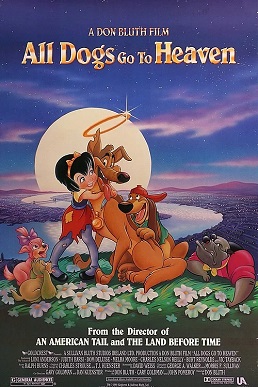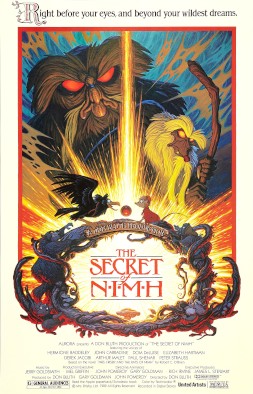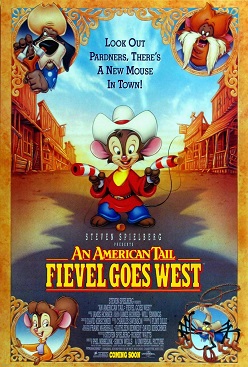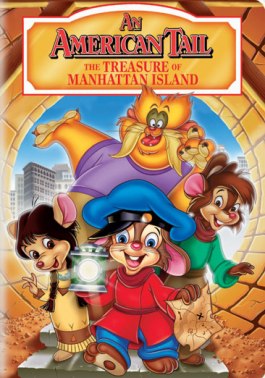Modern animation in the United States from the late 1980s to the early 2000s is frequently referred to as the renaissance age of American animation. During this period, many large American entertainment companies reformed and reinvigorated their animation departments, following the dark age, and the United States had an overall profound effect on animation globally.

All Dogs Go to Heaven is a 1989 animated musical fantasy comedy-drama film directed by Don Bluth and co-directed by Gary Goldman and Dan Kuenster. Set in New Orleans in 1939, it tells the story of Charlie B. Barkin, a German Shepherd that is murdered by his former friend, Carface Carruthers. Charlie escapes from Heaven to return to Earth where his best friend, Itchy Itchiford, still lives, in order to take revenge on Carface. Instead, he ends up befriending a young orphan girl named Anne-Marie. In the process, Charlie learns an important lesson about kindness, friendship and love.

The Secret of NIMH is a 1982 American animated fantasy adventure film directed by Don Bluth in his directorial debut and based on Robert C. O'Brien's 1971 children's novel, Mrs. Frisby and the Rats of NIMH. The film features the voice of Elizabeth Hartman as the protagonist Mrs. Brisby along with those of Peter Strauss, Arthur Malet, Dom DeLuise, John Carradine, Derek Jacobi, Hermione Baddeley, and Paul Shenar. It was produced by Bluth's production company Don Bluth Productions in association with Aurora Productions.

Donald Virgil Bluth is an American filmmaker, animator, and author. He is best known for directing the animated films The Secret of NIMH (1982), An American Tail (1986), The Land Before Time (1988), All Dogs Go to Heaven (1989), Anastasia (1997), and Titan A.E. (2000), for his involvement in the LaserDisc game Dragon's Lair (1983), and for competing with former employer Walt Disney Productions during the years leading up to the films that became the Disney Renaissance. He is the older brother of illustrator Toby Bluth.

Amblin' Entertainment, Inc., formerly named Amblin Productions and Steven Spielberg Productions, is an American film production company founded by director and producer Steven Spielberg, and film producers Kathleen Kennedy and Frank Marshall in 1980. Its headquarters are located in Bungalow 477 of the Universal Studios backlot in Universal City, California. It distributes all of the films from Amblin Partners under the Amblin Entertainment banner.

The Land Before Time is a 1988 animated adventure film directed and produced by Don Bluth from a screenplay by Stu Krieger and a story by Judy Freudberg and Tony Geiss; it is executive produced by Steven Spielberg, George Lucas, Kathleen Kennedy, and Frank Marshall. The film stars the voices of Gabriel Damon, Candace Hutson, Judith Barsi, and Will Ryan with narration provided by Pat Hingle. It is the first film in The Land Before Time franchise.

An American Tail: Fievel Goes West is a 1991 American animated Western musical film directed by Phil Nibbelink and Simon Wells, with producer Steven Spielberg for Amblin Entertainment and animated by his Amblimation animation studio and released by Universal Pictures. A sequel to 1986's An American Tail, the film follows the story of the Mousekewitzes, a family of Russian-Jewish mice who emigrate to the Wild West. In it, Fievel is separated from his family as the train approaches the American Old West; the film chronicles him and Sheriff Wylie Burp teaching Tiger how to act like a dog.

Amblimation was the British animation production subsidiary of Amblin Entertainment. It was formed by Steven Spielberg in May 1989, following the success of Who Framed Roger Rabbit (1988), and after he parted ways with Don Bluth, due to creative differences. It was stationed in what was originally the D. Napier & Son factory in Acton, London and had 250 crew members from 15 different nations. It only produced three feature films: An American Tail: Fievel Goes West (1991), We're Back! A Dinosaur's Story (1993), and Balto (1995), all three of which were composed by James Horner and distributed by Universal Pictures. The company's mascot, Fievel Mousekewitz, appears in its production logo.

Fievel's American Tails is an animated television series, produced by Amblin Television, Nelvana, and Universal Cartoon Studios. It aired on CBS for one season in 1992, and continued Fievel's adventures from the film An American Tail: Fievel Goes West. Phillip Glasser, Dom DeLuise and Cathy Cavadini were the only actors from the film to reprise their roles, as Fievel, Tiger and Tanya respectively. One character, Wylie Burp, is written off from this show following the respect of James Stewart's retirement. Another character, Tony Toponi, is written off following Pat Musick's then-current parenting of her daughter Mae Whitman, as Tony could not reappear until the DTV sequels in the late 1990s. He only made cameos in Fievel Goes West owing to that respect.

Gary Wayne Goldman is an American film producer, director, animator, writer and voice actor. He is known for working on films with Don Bluth such as All Dogs Go to Heaven for his directorial debut, Anastasia, An American Tail, and The Land Before Time. He was an animator at Disney before working at Sullivan Bluth Studios with Bluth.

Rock-a-Doodle is a 1991 independent live-action/animated musical comedy film produced by Sullivan Bluth Studios Ireland Limited and Goldcrest Films. Loosely based on Edmond Rostand's 1910 comedy play Chantecler, Rock-a-Doodle was directed by Don Bluth and written by David N. Weiss. The film features the voices of Glen Campbell, Christopher Plummer, Phil Harris, Charles Nelson Reilly, Sorrell Booke, Sandy Duncan, Eddie Deezen, Ellen Greene, and Toby Scott Ganger.

An American Tail: The Treasure of Manhattan Island is a 1998 American animated adventure film produced by Universal Cartoon Studios and directed by Larry Latham. It is the third film in the An American Tail series, the first to be released direct-to-video, and the first in the series to use digital ink and paint.

An American Tail: The Mystery of the Night Monster is a 1999 American animated adventure film directed and produced by Larry Latham. It is the second direct-to-video follow-up to An American Tail as well as the fourth and final film of the series. The film premiered on December 9, 1999, in Germany, and was released on July 25, 2000, in the United States and Canada. While the actors retain their voices for the original characters, this film introduces new characters and voices of Susan Boyd, Robert Hays, John Garry, Candi Milo, John Mariano, Jeff Bennett, and Joe Lala, completely omitting the previous film’s characters. Universal Cartoon Studios discontinued the franchise while moving on to work on sequels based on The Land Before Time during the 21st century. Thomas Dekker received a Young Artist Award for Best Performance in a Voice-Over for Fievel.

David Maxwell Kirschner is an American film and television producer and screenwriter. His producing credits include Don Bluth's An American Tail and Titan A.E. animated features as well as the Child's Play horror film series.

Banjo the Woodpile Cat is a 1979 American animated short film directed by Don Bluth. It follows the story of Banjo, an overly curious and rebellious kitten who, after getting into trouble for falling from a house to see if he could land on his feet, runs away from his woodpile home in his owners' farm in Payson, Utah by catching a truck to Salt Lake City. Produced on a shoestring budget, and created in Bluth's garage, the film took four years to make and it was the first production of Don Bluth Productions, later Sullivan Bluth Studios. It premiered theatrically on November 16, 1979, and at the USA Film Festival one year later on March 28, 1980. It was released on DVD by 20th Century Fox Home Entertainment on May 20, 2014.
Don Bluth Entertainment was an Irish-American animation studio established in 1979 by animator Don Bluth. Bluth and several colleagues, all of whom were former Disney animators, left Disney on September 13, 1979, to form Don Bluth Productions, later known as the Bluth Group. This studio produced the short film Banjo the Woodpile Cat, the feature film The Secret of NIMH, a brief animation sequence in the musical Xanadu, and the video games Dragon's Lair and Space Ace. Bluth then co-founded Sullivan Bluth Studios with American businessman Gary Goldman, John Pomeroy and Morris Sullivan in 1985.

Patricia Anne Musick is an American voice actress who has provided numerous voices in many television shows, films, and video games.

Phil Nibbelink is an American animator and film director as well as comic book writer and illustrator known for his work on films as the Academy Award-winning Who Framed Roger Rabbit and the 1991 cult animated sequel An American Tail: Fievel Goes West.

The Disney Renaissance was a period from 1989 to 1999 during which Walt Disney Feature Animation returned to producing critically and commercially successful animated films. These were mostly musical adaptations of well-known stories, similar to the films produced during the era of Walt Disney from the 1930s to 1960s. The resurgence allowed Disney's animated films to become a powerhouse of successes at the domestic and foreign box office, earning much greater profits than most of the Disney films of previous eras.
An American Tail is a franchise based on the 1986 animated feature film of the same name directed by Don Bluth and produced by Sullivan Bluth Studios/Amblin Entertainment.

















